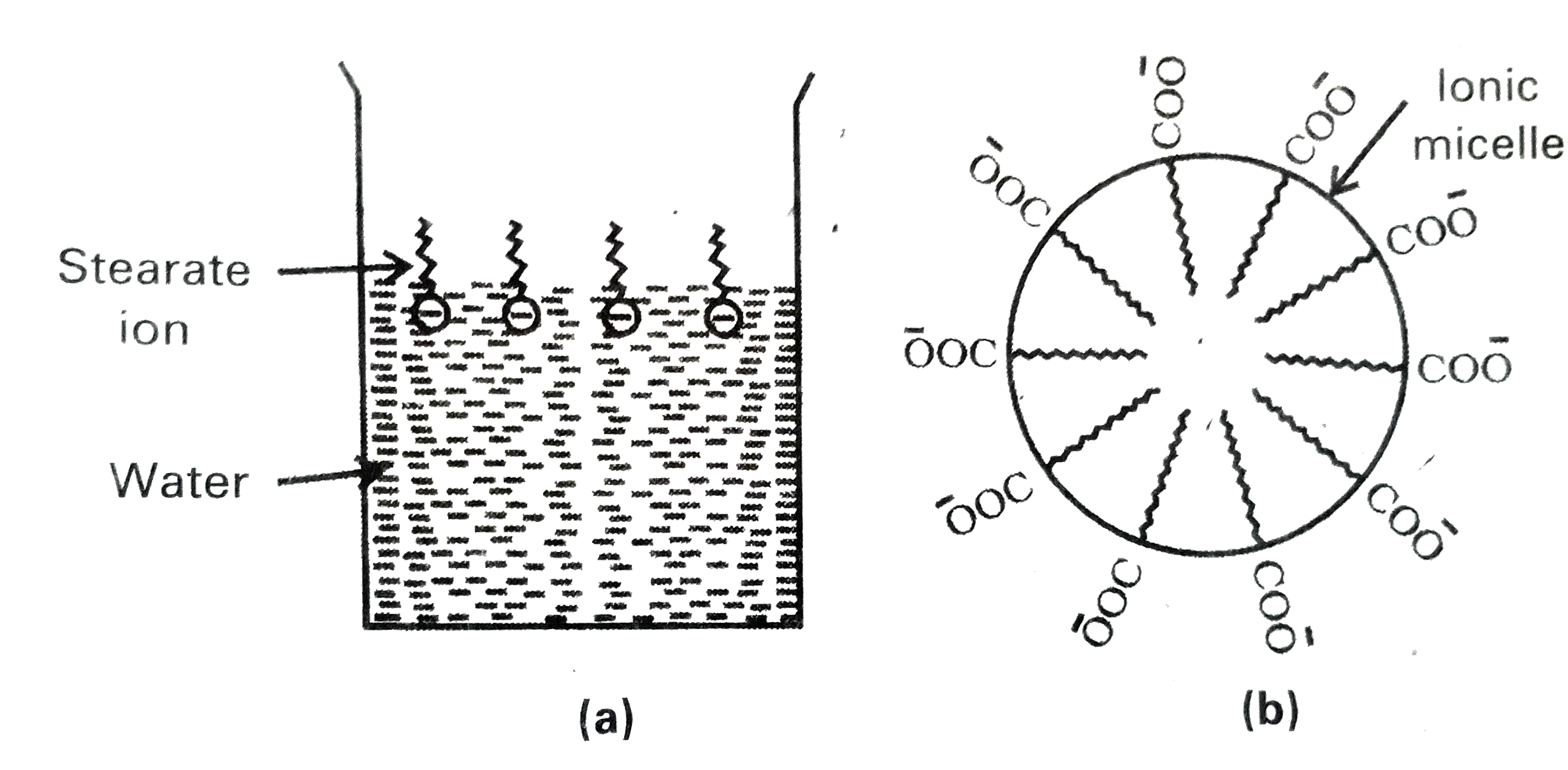Explain the formation of micelles with a neat sketch.Solution in Telugu
Mechanism of micelle formation : Let us take the example of soap solution. Soap is sodium or potassium salt of a higher fatty acid and may be represented as (e.g., sodium strearate , which is a major component of many bar soaps). When dissolved in water, it dissociates into ions. The ions, however, consist of two parts- a long hydrocarbon chain R (also called non-polar 'tail') which is hydrophobic (water repelling), and a polar group (also called polar-ionic 'head'), which is hydrophilic (water loving).
The ions are, therefore, present on the surface with their groups in water and the hydrocarbon chains (R) staying away from it and remain at the surface. But at critical micelle concentration, the irons are pulled into the bulk of the solution and are aggregated to form a spherical shape with their hydrocarbon chains pointing towards the centre of the sphere with part remaining outward on the surface at the sphere.
The aggregate thus formed is known as 'ionic micelle'. These micelles may contain as many as 100 simple molecules.
Similarly, in case of detergents, e.g., sodium laurylsulphate. , the polar group is along with the long hydrocarbon chain. Hence, the mechanism of micelle formation here also is same as that of soaps.

Topper's Solved these Questions
- SURFACE CHEMISTRYBook:VIKRAM PUBLICATION ( ANDHRA PUBLICATION)Chapter:SURFACE CHEMISTRYExercise:LONG ANSWER QUESTION
Explore 13 Videos
- SURFACE CHEMISTRYBook:VIKRAM PUBLICATION ( ANDHRA PUBLICATION)Chapter:SURFACE CHEMISTRYExercise:INTEXT QUESTIONS
Explore 8 Videos
- SURFACE CHEMISTRYBook:VIKRAM PUBLICATION ( ANDHRA PUBLICATION)Chapter:SURFACE CHEMISTRYExercise:INTEXT QUESTIONS
Explore 8 Videos
- SOLUTIONS Book:VIKRAM PUBLICATION ( ANDHRA PUBLICATION)Chapter:SOLUTIONS Exercise:INTEXT QUESTIONS
Explore 10 Videos
- TELANGANA MARCH-2019Book:VIKRAM PUBLICATION ( ANDHRA PUBLICATION)Chapter:TELANGANA MARCH-2019Exercise:SECTION C
Explore 6 Videos
Similar Questions
Explain the terms absorption, adsorption and sorption. Describe the different types of adsorption.
View SolutionWrite any two characteristics of Chemisorption.
View SolutionWrite any two characteristics of Chemisorption.
View SolutionCalculate the mole fraction of benzene is solution containing 30% by mass in carbon tetrachloride.
Then calculate the mole fraction by using the formula
Mole fraction of a component =Number of moles of the componentTotal number of moles of all components
xA=nAnA+nB
View SolutionHow is chlorine prepared by Deacon's process ? Explain its reactions with Hot Conc. NaOH, H2SandNa2S2O3.
View SolutionExplain sliding filament theory of muscle contraction with neat sketches.
View SolutionExplain the mechanism of breathing with neat labelled sketches.
View SolutionExplain with a neat sketch the phenomenon of electrophoresis.
View SolutionWith a neat labelled diagram explain Rainbow Formation.
View Solutionविस्पन्द का अर्थ स्पष्ट कीजिए तथा स्वच्छ आरेख द्वारा विस्पंदों का बनना समझाइए
View SolutionExplain the mechanism of breathing.
View SolutionWith a neat labelled sketch, explain the structure of pBR 322.
View SolutionExplain the proces of budding in Yeast with neat sketch.
View SolutionExplain mechanism of micelle formation by giving an example.
View SolutionExplain the mechanism of breathing with neat labelled sketches.
View Solution

